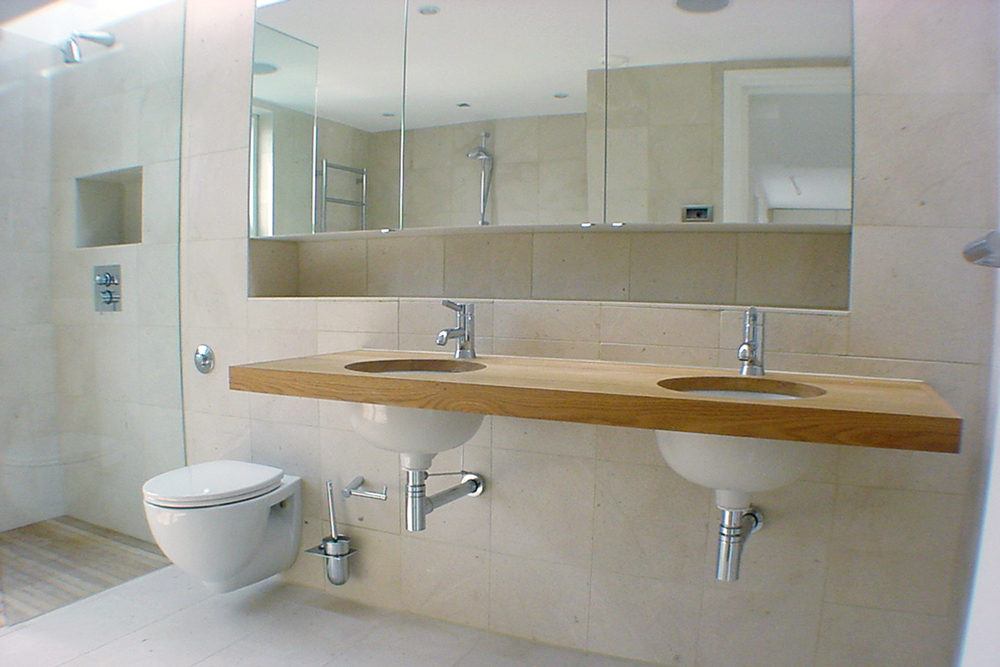
Ask anyone who’s survived a renovation how it went and chances are you’ll hear stories about budgets stretched to breaking point, termites discovered, builders gone bankrupt and work put on hold.
Even a mini crisis, like a delivery mishap or measuring error, can make renovating a stressful event.
But there are tricks to minimising or being prepared for problems.
‘It’s important to start with a realistic expectation that you’re going to encounter a lot of surprises, especially if you’re working with an old home,’ says Melbourne architect Ed Ewers.
‘Every time you pull away a layer, hope for the best but assume the worst.’
Ed upgraded a classic 1930s cottage, staying true to the traditional style at the front of the house but modernising the back with a sloping roof and feature walls.
1. Factor for budget blow outs
The most common complaint of first-timers is that everything costs more than expected.
Overspend often results from not recognising that changes cost extra.
It’s standard for builders to write into the contract that alterations after work has started incur an additional cost, often an extra 10 to 20.
MAKE IT WORK Most renos are fairly unpredictable so it’s almost impossible to lock in an exact price. Do the sums then factor in a contingency fund of up to 20 to cover any emergencies.
Says Ed, ‘We tell our clients to have about 5 in reserve. Usually all the nasties are found in the first stages of work, so if you get through the initial demolition you know what problems you’re dealing with.’
2. Choose a reputable builder
Whether it’s poor quality work, overcharging or bad communication, the repercussions of having a dodgy builder or tradie can last for years.
Remo and Tracy Sica’s builder went bankrupt after doing substandard work. ‘The renovation has been redone at a further cost of $150,000 plus another two years,’ Tracy says.
MAKE IT WORK Do the research, get at least three quotes and check that the builders are quoting for the same inclusions and allowances.
Nicky Hurst says, ‘Personal recommendations are important. Also visit the Department of Fair Trading in your state to check the builder is licenced and insured, and the licence matches the name on the contract. Visit their previous work, talk to ex clients and go with your gut feeling.’
Keeping it real
This late Victorian home in Sydney had plenty of challenges, including fibro extensions and six layers of flooring. But the owners were experienced with period homes so had allocated budget and time well above the initial estimates.
‘We were brought in because our carpenters are experienced at traditional techniques,’ says Nicky Hurt of James Hurt Building & Construction in Sydney.
‘We even hand-cut the cedar shingles so it was a good match of abilities and expectations.’

Before: Since being built in 1898 the house had been extended many times

After: Builders with heritage experience were used to strip back and renovate the house for a traditional finish
3. Have a watertight contract
Many disaster stories are linked to bad contracts and homeowners locked into agreements they can’t get out of.
Remo and Tracy discovered too late that their contract didn’t protect them from poor building work.
‘A contract should have ironclad escape clauses regarding lateness and the quality of work. Otherwise the builder can claim he’s completed a wall even if it’s not straight,’ says Tracy.
MAKE IT WORK Read the fine print before signing and understand every clause. If in doubt, run it past a lawyer.
Also check protection against delays and poor quality, and be clear about how much extra you’ll pay for any variations. If the builder wants to add 20 to any variation required during construction you might be able to negotiate that down to 15.
4. Expect timeline stretches
While ordering materials and booking subcontractors is the builder’s job, some decisions are the homeowner’s.
‘If you’re going to order things with six to eight weeks’ lead time, get in early so you don’t hold upthe builder,’ says Robert Harwood of My Architect.
MAKE IT WORK Avoid renovating around time-sensitive events, such as a new baby or family coming to stay. Steer clear of the Christmas period, when much of the building industry takes two weeks off. Make sure the contract has a clause that includes a penalty for the builder if delays go past a certain point.

‘Late delivery of bathroom fittings can cause building delays, so order them ahead to avoid holding up installation,’ says Robert
5. Be flexible with solutions
Renovator Jane Slack-Smith found there was no sewerage connection to an outside toilet she had planned.
Jane stuck to her guns and it cost thousands to install. ‘But we don’t use it, so it was a waste of money,’ she says.
A successful choice she made was to restore the front to the original period style, painting the exterior in one colour to improve the streetscape.
MAKE IT WORK Look at the big picture and be prepared to make changes if you come across problems once building has started. Keep an open mind and consider expert advice when looking for the best solutions.

Before: An overgrown patch of lawn and rusted fencing made the cottage look neglected

After: Jane restored the window and upgraded the front with paint and landscaping to modernise the house
6. Expect surprises
Surprises can be unearthed during demolition and there is the risk of finding termites, damp, electrical or underpinning problems. Do inspections for termites and damp plus structural checks as early as possible so you know what
to expect and can set budgets and timelines to suit.
7. Don’t overspend
Overspending results in a house that costs more than it’s worth in the current market. The key is to spend in the right places. Consult a real estate agent to compare the costs of renovating against the value of similar houses in the area. You can usually spend more if you’re going to stay for a long time.
8. Visit the site often
Many mistakes can be avoided simply by being on site. If problems, like the wrong appliance being delivered, are noticed early they can be solved with minimum extra cost and stress. Even with a project manager, allocate as much time as possible to visiting the site.
9. Book jobs in sequence
Problems hit at the end during the busy stage when hardware is fitted and all the tradies are there. Be on site often and in frequent contact with the builder or project manager about the schedule. Stay organised and practical, for example don’t book carpet layers until the messy jobs are done.
10. Budget for landscaping
Landscaping often drops off or is left at the end of the list. Don’t underestimate the cost as it’s labour intensive and can be expensive. Get quotes at the beginning so you can allocate part of the budget. Plan for major outdoor earthworks at the same time as reno excavations to provide machinery access.
Costly corrections
The wrong paint colour on a wall is easily fixed but other mistakes can really blow the budget.
RELAYING TILES ramps up the cost of something seemingly simple like swapping an old wall-hung tap for a new one.
MOVING PLUMBING is always expensive so get your bathroom, kitchen and laundry layouts right because changing the pipework means a massive additional outlay once they’re set in place.
MISCALCULATING MATERIALS can be disastrous, especially if dealing with marble or imported limestone, which needs to be treated like gold when measuring, ordering and installing.

